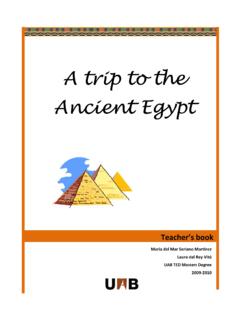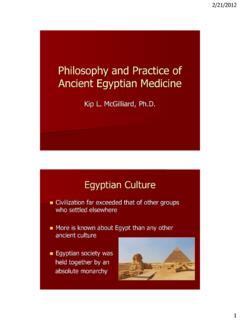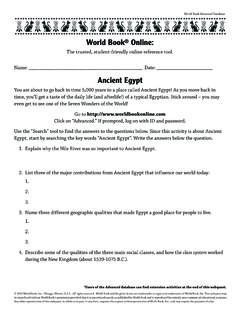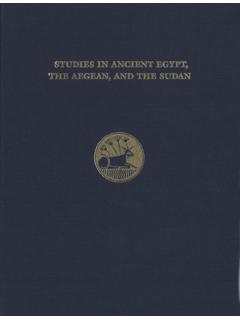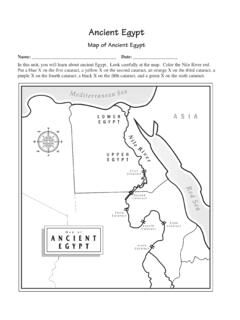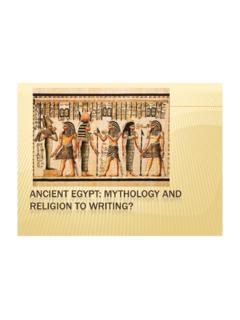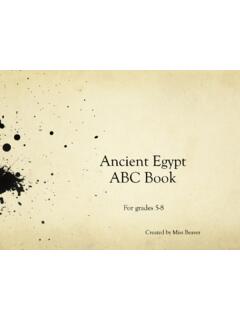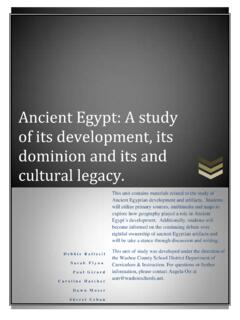Transcription of How Did the Nile River Shape Ancient Egypt's Society?
1 Mini-Qms in World History Volume 1, Unit 2 How Did the Nile River Shape Ancient Egypt's Society? MINI-Q'" LESSON PLAN I DAY 1 - 45 minutes I Step One: Hook Refer to the Step One teacher notes in the Mini-Q. Read the directions aloud. The purpose is to get students engaged, talking, and wanting to do the Mini-Q. Step Two: Background Essay Refer to the Step Two teacher notes in the Mini-Q. Students can write out answers to the BGE questions or the questions can simply be discussed. Step Three: Understanding the Question and Pre-Bucketing The task of recognizing and r defining key words in the question is a crucial habit of mind. The second task of pre-bucket ing based on clues in the question and in document titles is a huge categorization skill. Step Four: Document Analysis Do Document A with the whole class, modeling the kind of detail you expect in student answers to the Document Analysis questions.
2 Homework: Analyze the remaining documents and answer the questions that follow. I DAY 2 - 45 minutes I Step Four (continued): Discussion of Documents Option One: Working in pairs or threesomes, have students discuss the answers to the first set of Document Analysis questions they did for homework. Using a different-colored pen than they used for homework, they may add to their answers. After five minutes, open the discussion of that document to the full class. Then proceed to the next document and repeat. Option Two: Proceed as above, but have a volunteer group lead each of the three or four different document discussions. Students at their desks may add to their notes, again in a different pen. Step Five: Bucketing and Chicken Foot Have students complete the bucketing and chicken foot work page.
3 This step will help students clarify their thesis and road map. Step Six: From Thesis to Essay Writing For Homework: Have students fill out the Outline Guide Sheet or write their multi-paragraph essay. I DAY 3 (Optional) I Step Six (continued): Conduct an in-class Writing Workshop. r MINI-QTM LESSON PLAN: CLEAN VERSION OPTION IF students are ready, use the Clear1 Versior~ of the Mini-Q, which requires them to handle more of the analysis on their own. Estimated time to complete is 1-2 class periods. 0 2011 The DBQ Project 47 The Nile & Ancient egypt Mini-Q How Did the Nile River Shape Ancient Egypt's Society? A wall painting from the tomb of Sennefer, mayor of Thebes and Overseer of the Royal Gardens during the reign of Amenhotep 11, 1426-1400 BCE. Overview: The glory days of Ancient egypt lasted almost 3,000 years.
4 They began about 2920 BCE with the unification of egypt under the first pharaoh and ended when the Romans conquered the kingdom in 30 BCE. Through this rich and vibrant civilization flowed the longest River in the world. The Nile, which meanders 4,126 miles across east Africa before ending its journey in egypt , brought life-giving water to the desert kingdom. This Mini-Q is about the importance of the Nile to the people of Ancient egypt . The Documents: Document A: Ancient egypt (map) Document B: The Nile River Flood Cycle (chart) Document C: Transportation on the Nile Document D: Field of Reeds (tomb painting) Document E: Hymn to the Nile A Mini Document Based Question (Mini-Q) O 201 1 The DBQ Project This page may be reproduced for classroom use The Nile & Ancient egypt Mini-Q Hook Exercise: Finding a New Homeland r Directions: It is several centuries before the time of Jesus Christ.
5 You are an elder in a goat-herding tribe of 500 people. Unfriendly raiders from the north, the Attakalots, are forcing you off your land. You send out a small party of men, armed mostly with your prayers, to search for a new homeland. Six months later, they return. That evening, around a large bonfire, the scouting party presents a rough map to the Council of Elders with four possible settlement sites. Examine the map with a fellow elder and discuss the pros and cons of each option. Which site will you recommend to the a council? Site A: Pros SiteB: Pros Cons Site C: Pros r Cons Cons Site D: Pros Cons 0 2011 The DBQ Project This page may be reproduced for classroom use Background Essay The Nile & Ancient egypt Mini-Q How Did the Nile River Shape Ancient Egypt's Society?
6 In today's fast-paced, digital society, it is easy to forget the importance of rivers. Ours is a world of highways and airports, of supermarkets and shopping malls. When we travel or want food, we don't think " River ." When we make a list of life's necessities, rivers don't make the cut. This has not always been the case. Four of the world's most important Ancient cultures are known by historians as the " River civilizations." These were Mesopotamia (on the Tigris-Euphra- tes River ), China (on the Yangste River ), India (on the Indus River ), and egypt (on the Nile). They are called the River civilizations because of the powerful influence a large River system had on the lives of the people. Nowhere was this in these regions of central Africa, the tributar- ies of the Blue and White Nile grow full and -9 flow into the main stream.
7 The mother Nile, its waters replenished, flows north and into egypt . There, the water spills over its banks and cov- ers the low-lying flood plain. For thousands of m years this flooding cycle has provided a seasonal rhythm for the Egyptian people. The flooding cycle determined the plant- ing season for farmers. Their main crops were barley and emrner-wheat for making bread and beer. People paid their taxes in wheat, and wheat was a main export. Farmers also grew flax, for producing fine linen, and harvested papyrus from the marshy areas along the River and in more true than in the Ancient kingdom of egypt . Ancient egypt was a world of contrasts and op- posites, a place of hot, sunny days and cold nights, of crop- laden fields and empty desert. In its early time, the kingdom was actually two distinct lands called Upper egypt (the higher the delta.)
8 Irrigation channels from the Nile flowed to smaller gardens where farmers grew vegetables such as onions, beans, and cucumbers. Date, fig, and pomegranate trees were tended along the River . 1 While fruits, grains, and vegetables might sound like the makings of a healthful diet, ground of southern egypt , where the Nile flows out of the mountains) and Lower egypt ( where the River spreads into a delta before emptying into the Mediterranean). Ancient egypt was also described in terms of contrasting colors: "Black Land" (kemet) referred to the fertile Nile valley, and its opposite, "Red Land" (deshret), referred to the deserts east and west of the River . Life in the black land was orderly and predictable, while the desert represented chaos and danger. For Egyptians, the Nile literally meant the dif- ference between life and death.
9 The source of the Nile was a mystery to the Ancient Egyptians. Now we know that one branch, called the Blue Nile, begins in Lake Tana and the highlands of Ethiopia. The other main branch, the White Nile, begins with the waters that flow into and then out of Lake Victo- ria in Kenya. Every year, when heavy rains fall one ingredient of Egyptian meals was definitely not good: desert sand. Sand was everywhere, easily settling into the dough for flat bread, a ba- sic food eaten by everyone. Once the ever-pres- ent sand ground down a person's teeth, infection and pain set in; thus, dental disease became a common medical problem in Ancient egypt . Let's time-travel to this fertile yet hostile land where life revolved around the ebb and flow of a single waterway. On the following pages are five documents that provide a glimpse of how Egyptians lived their lives thousands of years ago.
10 As you read the documents, think about how the Nile gave rise to a civilization that, all this time later, continues to fascinate. Then answer the question before us: How did the Nile River Shape Ancient Egypt's society? 9 0 2011 The DBQ Project 53 This page may be reproduced for classroom use The Nile & Ancient egypt Mini-Q Background Essay Questions r 1. Name four important River civilizations of the Ancient world. 2. List two or three pairs of contrasts that describe Ancient egypt . 3. What are two of the sources of the Nile? 4. How did the flooding cycle provide a seasonal rhythm for the Egyptian people? 5. Why was sand a health threat for Egyptians? 6. Define these terms: Black Land Red Land tributaries papyrus r irrigation Timeline 2920-2575 - Early Dynastic Period: The first pharaohs unify egypt into a powerful kingdom 2575-2134 - Old Kingdom: big advances in technology and architecture; pyramids built at Giza 2040-1 640 - Middle Kingdom: Egypt's population, religion and the arts flourish 1550-1 070 - New Kingdom: kingdom expands into Syria and Nubia; international trade routes established 712-332 - Late Period: Persians invade and annex egypt 332-304 - Alexander the Great defeats Persians.
